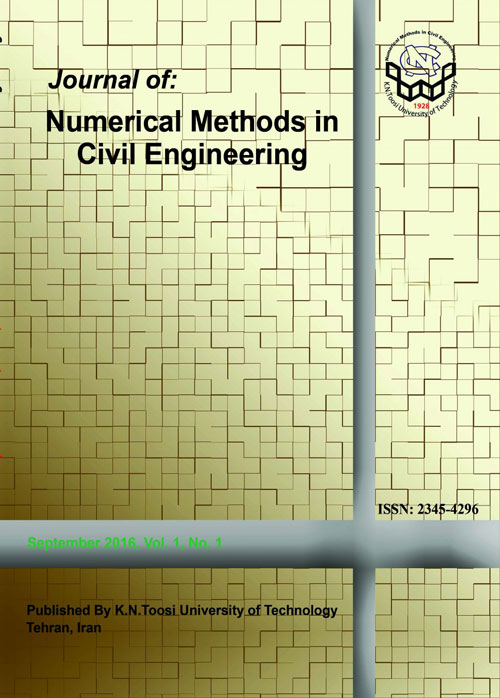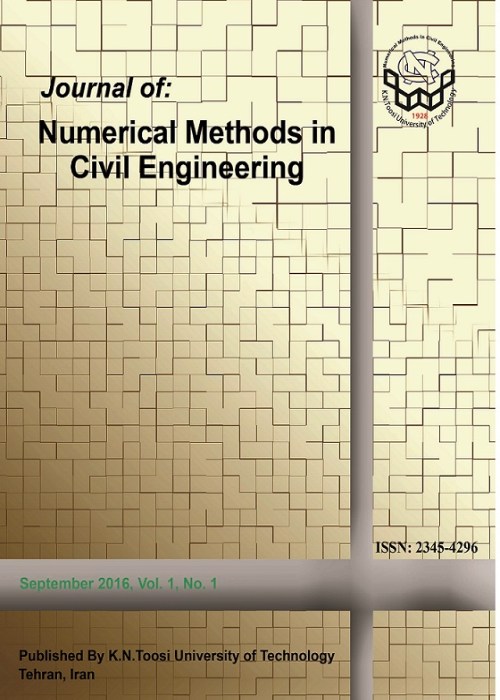فهرست مطالب

Journal of Numerical Methods in Civil Engineering
Volume:1 Issue: 3, Mar 2015
- تاریخ انتشار: 1396/06/13
- تعداد عناوین: 7
-
-
Pages 1-15This paper presents a novel procedure for solving the equations system of the rotating crack model used for reinforced concrete. It is implemented in the programme NonOPt where it is used to optimise the reinforcement design of D regions. The procedure is based on solving explicit closed-form relations without the need to incrementally increase the applied loads. The solution procedure is based on a secant modulus approach and is developed initially on the basis that the stress-strain response of the steel and concrete is linearly elastic. Subsequently the effect of material nonlinearities is included and the solution procedure is adapted accordingly. A reinforcement design procedure for membrane elements is described along with some case studies. The design procedure minimises the amount of reinforcement required to satisfy predefined design constraints. Material nonlinearities are taken into account, stress and strain compatibilities are satisfied and the design considers both the ultimate and serviceability limit states through the application of appropriate design constraints.Keywords: reinforced concrete, membrane element, closed-form relations, nonlinear analysis, reinforcement design, D regions
-
Pages 16-23Beam connections with reduced drilled section and slotted web have been presented after the Northridge earthquake (1994). Their new geometrical shapes have been resulted in weakening of beams and subsequently the bette rperformance of connections in the earthquakes. In this research, the advantages of both connections, mentioned above, have been studied in the Slotted Web Drilled Flange (SWDF) composite connections. Accordingly, the effects of different parameters of slot such as length, width and end hole dimension have been assessed as well. Based on the results obtained in this research,energy dissipation is reduced due to the increase of length of slot web in the SWDF connection, exceeded the values recommended in the codes. Besides, the stability of hysteresis curve decreases because of increasing in the width and end hole diameter of web slot.Keywords: Slotted Beam Web, Reduced Beam Section, Seismic Performance, Drilled Flange, Energy Dissipation
-
Pages 24-33Clean drinking water for the municipality of Rey with population of over one million remains a critical and serious problem. In particular, Reys continued water demands has caused a substantially high drop in its local groundwater level. With running this study, we can appropriately predict the quality of groundwater in Rey. In this study, we have considered presence of nitrate contaminant as the most suitable index representing groundwater contamination or pollution. For example, such index is capable of high solubility in water has a low absorption rate and exhibits relatively sustained compound stability. Moreover, the PMWIN software code was employed to model quality of associated aquifers. In addition, we analyzed data from Rey drinking water wells, which were collected and processed during the period of 2005 to 2012. We further evaluated: values of longitudinal and latitudinal diffusions, and absorption coefficient. A drop in the groundwater levels was measured 1.5 to 5 m for the eastern part of Rey and 5 to 11 m for the central zone of the municipality. For the western part of Rey, a drop in ground water levels in excess of 22 m were noted. In this paper, the value of Nitrate was determined and compared with standard values presented by EPA.Keywords: Modeling, Nitrate, Rey, Pollution, Groundwater, PMWIN-5.3, MT3D
-
Pages 34-45Different expressions have been developed to determine damping of structures based on various hysteretic models and ductility levels. Since Slenderness ratio is an important parameter on the hysteretic behavior of special concentrically- braced frames (SCBF), in this paper new expressions for determination of damping of such frames are developed based on slenderness ratio and ductility. Two types of SCBF are considered: Inverted V braced frame and X braced frame. Using Jacobsen method, damping is determined and then modified by means of nonlinear time history analysis for special inverted V and X braced frames. A simplified methodology is proposed by using revised effective mass to modify the hysteretic damping. Using the simplified methodology, expressions are proposed to estimate damping for special concentrically- braced frames.Keywords: Ductility, Damping, Slenderness Ratio, SpecialCon-Centrically braced- frame
-
Pages 46-54This research reveals the efficiency of seismic isolation system in the form of rubber-metal supports with different height buildings at multi component seismic impact. As an example, seismically insulated monolithic reinforced concrete 5, 9 and 16 story buildings are considered. The solution of the problem is obtained by a direct integration of the motion equations for an explicit scheme in finite element formulation developed in the software package LS-DYNA. The calculation is performed considering nonlinear nature of rubbermetal supports. The analysis of the effectiveness of buildings with seismic insulation and without it is performed and the obtained results are presented.Keywords: Seismic, rubber-metal, Rubber-metal supports, seismic resistance
-
Pages 55-66A plasticity-fracture constitutive model is presented for prediction of the behavior of confined plain concrete. A three-parameter yield surface is used to define the elastic limit. Volumetric plastic strain is defined as hardening parameter, which together with a nonlinear plastic potential forms a non-associated flow rule. The use of non-associated flow rule improves the prediction of the dilation behavior of concrete under compressive loading. To model the softening behavior, a fracture energy-based function is used to describe strength degradation in post-peak regime. The Euler-forward algorithm is used to integrate the constitutive equations. The proposed model is validated against the results of triaxial compressive experiments. Finally, the behavior of plain concrete confined by layers of carbon fiber reinforced polymer is studied to show capability of the model for passive confinement.Keywords: Plasticity-fracture, Constitutive model, Confined concrete
-
Pages 67-75The objective of this paper is to describe governing numerical equation and solution algorithm of pollution transport mechanisms and factors essential to include in developing relatively simple and practical tools to quantify pollution loss, advection, diffusion and sorption in pollution transport into the groundwater at landfill sites. This paper presents the development of a numerical model that can be used for quantifying groundwater inputs and associated contaminant discharge from a landfill into the affected aquifer. The results reveal that the proposed model can be used for the simulation of contaminant transport in aquifers in any scale. This numerical solution is established on finite difference-finite-volume solution advection-diffusion-linear sorption with first order decay equation. To show the capability of proposed model, the results of a case study presented in the paper as simulating leachate transport at a 2000 ton/day landfill facility assesses leachate migration away from the landfill in order to control associated environmental impacts, particularly on groundwater wells down gradient of the site. Leachate discharge from landfills is the main route for release of the organic and inorganic contaminants through subsurface, commonly encountered in the refuse. Leachate quantity and potential percolation into the subsurface are estimated by the proposed model. A comprehensive sensitivity analysis to leachate transport control parameters was also conducted. Sensitivity analysis suggest that changes in source strength, aquifer hydraulic conductivity, and dispersivity have the most significant impact on model output indicating that these parameters should be carefully selected when similar modeling studies are performed. The sensitivity of the model to variations in input parameters results in two opposing patterns of contaminant concentration. While higher groundwater velocities increase the speed of plume spread, they also increase the dilution ratio and hence Decrease the concentration.Keywords: Advection, Diffusion, Sorption, First Order Reaction Equation, Finite Volume, Finite Difference, Sensitivity Anal


